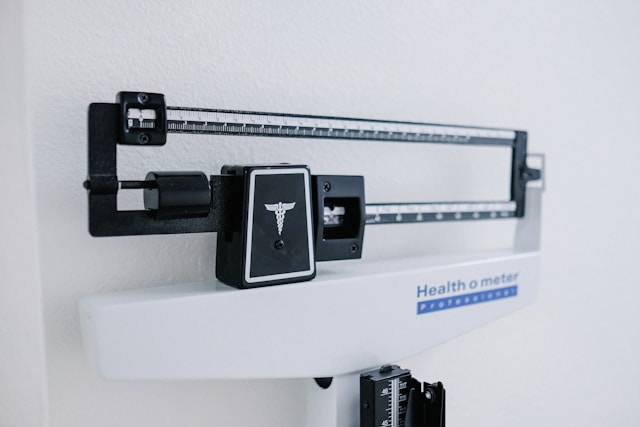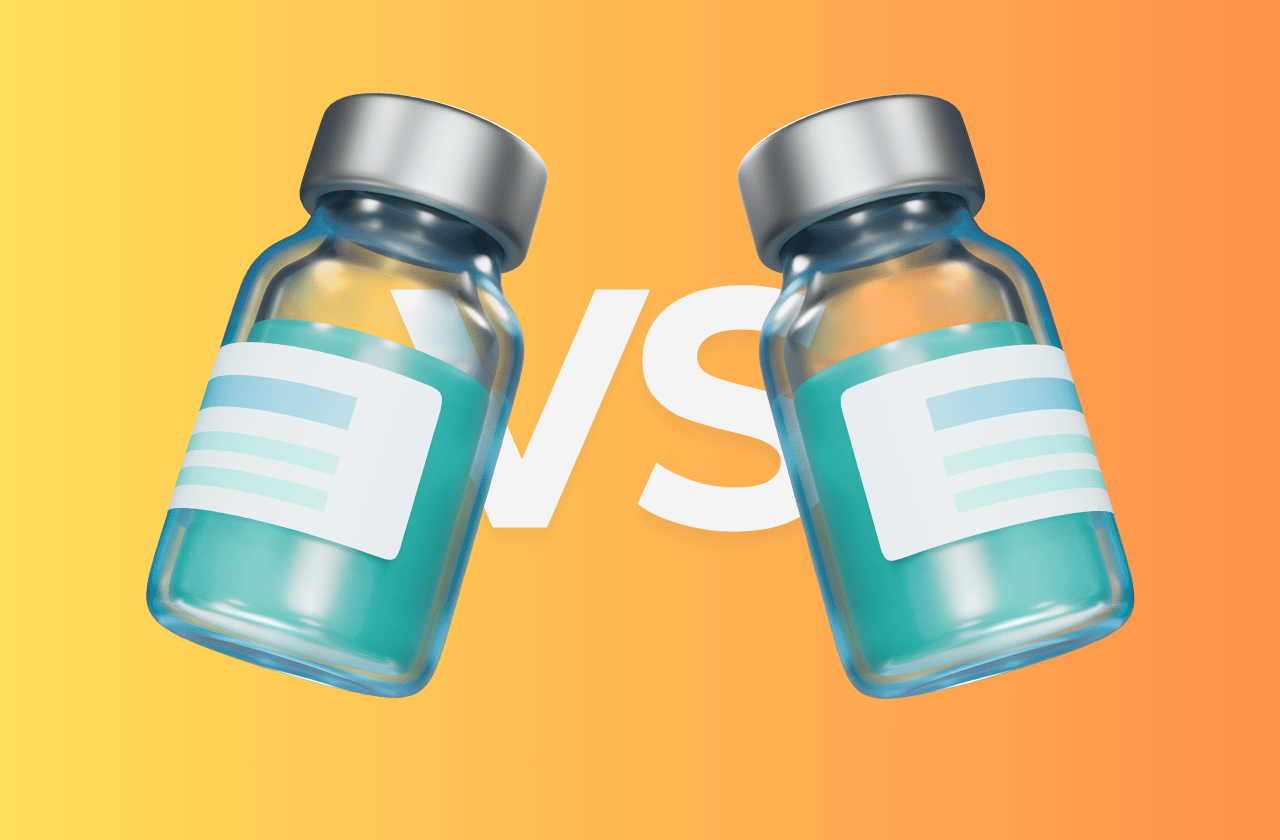[Disclaimer: This article is for informational purposes only and does not constitute medical advice. Always consult with a qualified healthcare provider before starting any peptide therapy.]
The weight loss peptide landscape has transformed dramatically in recent years, and two names are generating serious buzz in clinical circles: retatrutide and tirzepatide.
If you’ve been following the latest developments in obesity treatment, you’ve probably heard whispers about these breakthrough medications from Eli Lilly that are changing how we think about weight management.
But here’s the thing – while they’re both incredibly promising, they’re at very different stages of development and approval. One is already helping thousands of people lose weight, while the other is still making headlines in research labs.
Let’s dive deep into what makes each of these medications special and help you understand which might be right for different situations.
Key Takeaways
- Tirzepatide is currently FDA-approved and available by prescription, while retatrutide is still in clinical trials and not yet available to patients
- Early studies suggest retatrutide may achieve slightly greater weight loss (24.2%) compared to tirzepatide (22.4%), but more research is needed to confirm long-term safety and effectiveness
- Both medications work differently: tirzepatide targets two hormone receptors while retatrutide targets three, potentially offering more comprehensive metabolic benefits
- Beyond weight loss, both medications show promise for improving blood sugar control, liver health, and other metabolic conditions
How These Medications Work
Before we get into the nitty-gritty comparisons, it’s worth understanding what makes these medications so buzzworthy. Both weight loss drugs work by mimicking hormones your body naturally produces to regulate appetite and metabolism – but they do it in distinctly different ways.
Retatrutide: The Potential Triple Threat Approach
Retatrutide is what scientists call a “triple-hormone receptor agonist,” and honestly, that’s as impressive as it sounds. This medication simultaneously targets three different metabolic receptors in your body: GLP-1, GIP, and glucagon receptors[1]. Think of it like having three different keys that unlock three different doors in your metabolism.
What’s particularly interesting about retatrutide is how it affects these receptors differently than your body’s natural hormones. It’s actually more potent at the GIP receptor by a factor of 8.9, while being less potent at glucagon and GLP-1 receptors[2].
This unique profile means it can potentially address multiple aspects of weight management simultaneously – reducing appetite, increasing energy expenditure, and improving how your body handles glucose.
The addition of glucagon receptor activation is what really sets retatrutide apart from other weight loss medications. This mechanism theoretically allows for more comprehensive metabolic regulation, addressing the complex web of factors that contribute to obesity.
Tirzepatide: The Proven Dual Agonist
Tirzepatide takes a different but equally sophisticated approach. It’s a dual agonist that targets both GIP and GLP-1 receptors[3], representing a significant advance beyond single-target medications like semaglutide (which you might know as Ozempic or Wegovy).
The way tirzepatide works is elegant in its simplicity: it primarily decreases appetite and slows gastric emptying[4] – essentially making you feel full longer and reducing how quickly food moves from your stomach to your small intestine. The synergistic effect of activating both receptor types contributes to its impressive efficacy in both blood sugar control and weight reduction.
Key mechanisms include:
- GLP-1 receptor agonist – promotes satiety, reduces food intake, and slows gastric emptying
- GIP receptor activation – enhances insulin secretion in response to elevated blood glucose and affects adipose tissue metabolism
Weight Loss Results: The Numbers That Matter

When it comes to weight loss medications, the proof is in the pudding – or rather, in the clinical trial results. Both medications have shown remarkable efficacy, but at different stages of development.
Retatrutide: Promising Early Results
The early clinical trial results for retatrutide are nothing short of spectacular. In a phase 2 double-blind, randomized controlled trial, participants receiving the 12 mg dose experienced an extraordinary 24.2% weight reduction at 48 weeks[4]. To put that in perspective, that’s nearly a quarter of someone’s body weight – one of the most substantial weight loss effects ever observed with any medication.
When researchers compared retatrutide directly to other diabetes medications, the results were equally impressive. A meta-analysis showed that retatrutide 12 mg reduced body weight by 11.83 kg more than dulaglutide 1.5 mg[2], while also showing a slight improvement in HbA1C levels.
But retatrutide’s benefits extend well beyond the scale. The medication has demonstrated significant improvements in metabolic markers in patients with overweight, obesity, and/or type 2 diabetes[1]. Perhaps most impressively, it’s shown remarkable efficacy in treating metabolic dysfunction-associated steatotic liver disease (MASLD), with significant reductions in liver fat content across all dosage groups[5].
Third-Party Tested, 99% Purity
Order lab-verified peptides from our top recommended vendor.

Tirzepatide: Demonstrated Weight Loss Efficacy
Tirzepatide has the advantage of extensive clinical trial data from multiple phase 3 studies. The SURMOUNT-1 trial demonstrated clear dose-dependent weight loss over 72 weeks, with participants achieving average weight reductions of 16.1 kg at 5 mg, 22.2 kg at 10 mg, and 23.6 kg at 15 mg[6]. These results significantly outperformed placebo, which produced only a 2.4 kg average weight loss.
But perhaps the most telling evidence comes from head-to-head comparisons. The SURMOUNT-5 trial directly compared tirzepatide to semaglutide (Wegovy), currently considered one of the leading weight loss medications. The results were clear: tirzepatide achieved 22.8 kg (50.3 pounds) or 20.2% body weight reduction compared to semaglutide’s 15.0 kg (33.1 pounds) or 13.7% body weight reduction[7]. That represents 47% greater relative weight loss with tirzepatide.
Quick Comparison: Retatrutide vs Tirzepatide
| Feature | Retatrutide | Tirzepatide |
|---|---|---|
| Mechanism | Triple agonist (GLP-1, GIP, Glucagon) | Dual agonist (GLP-1, GIP) |
| Development Stage | Phase 3 trials (investigational) | FDA approved |
| Maximum Weight Loss | 24.2% (48 weeks, Phase 2) | 22.4% (72 weeks, Phase 3) |
| Current Availability | Clinical trials only | Prescription available (Zepbound/Mounjaro) |
| Key Differentiator | Glucagon receptor activation | Established safety profile |
| Special Benefits | Dramatic liver fat reduction (82.4%) | Proven cardiovascular benefits |
Safety Profiles: What You Need to Know
Understanding the safety profile of any medication is crucial, especially when it comes to treatments you might use long-term.
Retatrutide: Still Under Investigation
Since retatrutide is still in clinical trials, its complete safety profile is still being characterized. Current data shows an increase in non-severe gastrointestinal and hypersensitivity adverse events compared to placebo[1], which is consistent with other medications in this class.
The triple-agonist mechanism theoretically introduces additional potential for both benefits and adverse effects compared to single or dual agonists. Phase 3 randomized controlled trials are expected to provide more comprehensive safety data, particularly regarding long-term use.
Tirzepatide: Well-Documented Safety Profile
Tirzepatide has a well-documented safety profile based on multiple clinical trials and growing real-world experience.
The most common side effects, affecting 5% or more of patients, include gastrointestinal symptoms (abdominal pain, burping, constipation, diarrhea, dyspepsia, nausea, vomiting), fatigue, gastroesophageal reflux disease, hair loss, hypersensitivity reactions, and injection site reactions[8].
More serious but less frequent adverse events include:
- Severe gastrointestinal problems and acute pancreatitis
- Acute kidney damage and gallbladder disease
- Serious allergic reactions and hypoglycemia
- Diabetic retinopathy complications in type 2 diabetics
- Potential psychiatric effects including suicidal ideation
Despite these potential serious side effects, tirzepatide is generally well-tolerated. The gastrointestinal side effects are typically mild-to-moderate and tend to be transient, often resolving as treatment continues.
However, it has been associated with a higher number of adverse events leading to treatment discontinuation compared to placebo[9].
Availability: What’s Available Now vs. What’s Coming

This is where the rubber meets the road in terms of practical considerations.
Retatrutide: The Waiting Game
As of May 2025, retatrutide remains an investigational medication currently in phase 3 clinical trials for obesity and related metabolic conditions. Multiple studies are underway examining its efficacy and safety for various indications, including obesity, type 2 diabetes, and metabolic dysfunction-associated steatotic liver disease.
While early results are promising, regulatory approval will depend on the outcomes of these ongoing studies and comprehensive safety evaluations. This means retatrutide is currently accessible only through clinical trials, not for general prescription.
Tirzepatide: Ready for Prime Time
Tirzepatide has already received FDA approval for two distinct indications: treatment of type 2 diabetes (marketed as Mounjaro) and weight management in adults with obesity or overweight with at least one weight-related condition (marketed as Zepbound).
This approved status makes tirzepatide immediately available for clinical use, and the substantial body of evidence supporting its efficacy and safety has facilitated its integration into clinical practice guidelines for obesity management.
Beyond Weight Loss: Additional Health Benefits
Both medications offer benefits that extend well beyond the number on the scale, which is particularly important given that obesity is associated with numerous health complications.
Retatrutide: Emerging Potential Benefits
Retatrutide’s triple-agonist mechanism may offer advantages in several areas beyond weight reduction. One of the most impressive findings involves liver health. A 48-week trial demonstrated dramatic reductions in liver fat at 24 weeks across all dosage groups[10]. This represents one of the most substantial improvements seen with any pharmacotherapy for MASLD.
Perhaps even more intriguing are the preclinical studies suggesting potential anti-cancer effects. Research indicates that retatrutide may have superior anti-cancer effects compared to single-agonist therapies, with pancreatic cancer engraftment being reduced, tumor onset delayed, and progression attenuated, resulting in a 14-fold reduction in tumor volume compared to only a 4-fold reduction with semaglutide[11].
Retatrutide has also demonstrated significant improvements across multiple metabolic parameters, including glycemic control, lipid profiles, and inflammatory markers[1].
Tirzepatide: Documented Metabolic Benefits
Tirzepatide offers several well-documented benefits beyond weight loss. For glycemic control, tirzepatide significantly lowers HbA1c levels with maximum reductions of 2.24% in patients with type 2 diabetes[12]. Its dual-agonist mechanism provides more robust glycemic control than many existing diabetes medications.
Evidence also suggests tirzepatide may provide cardiovascular benefits[13], although specific outcomes are still being evaluated in dedicated cardiovascular trials.
One particularly valuable application is in maintaining weight loss. The SURMOUNT-3 trial demonstrated that tirzepatide can help maintain and even enhance weight loss achieved through intensive lifestyle interventions, addressing a critical challenge in obesity management[14].
Tirzepatide also significantly reduces waist circumference, with an average reduction of 7.2 inches (18.4 cm) reported in the SURMOUNT-5 trial[7]. This reduction in central adiposity may have particular cardiometabolic benefits.
Looking Ahead: The Future of Weight Loss Medicine

Both medications represent significant advances in obesity pharmacotherapy, but they’re at different stages of development and availability.
Retatrutide: Investigating Future Possibilities
If phase 3 trials confirm the remarkable weight loss observed in phase 2 studies, retatrutide could potentially set a new standard for pharmacological obesity treatment. The triple-agonist approach may offer advantages over dual-agonist therapies, particularly for patients with multiple metabolic complications.
Ongoing research aims to establish long-term safety and efficacy, explore additional therapeutic applications including non-alcoholic steatohepatitis and cardiovascular disease prevention, compare efficacy directly with established therapies, and determine optimal dosing strategies for different patient populations.
Tirzepatide: Expanding Applications
As an established therapy, research on tirzepatide is focusing on long-term safety and efficacy data collection, exploring additional indications beyond obesity and type 2 diabetes, identifying patient subgroups most likely to benefit, optimizing treatment protocols, and understanding mechanisms for treatment resistance.
Tirzepatide has already demonstrated potential for expanded applications, including metabolic dysfunction-associated steatotic liver disease and cardiovascular disease prevention.
Are Tirzepatide and Retatrutide Right for You?
The choice between these medications isn’t really a choice at all right now – tirzepatide is available and retatrutide isn’t. But understanding both can help you make informed decisions about your weight management journey.
For healthcare providers, tirzepatide currently represents a proven option for patients requiring pharmacological intervention for obesity. Its established efficacy, safety profile, and regulatory approval make it a valuable tool in the current treatment arsenal.
For patients, tirzepatide offers immediate access to a highly effective weight loss medication with extensive clinical trial data supporting its use. The dual-agonist mechanism provides substantial weight loss and metabolic benefits that go well beyond what traditional weight loss treatments can achieve.
Looking forward, retatrutide may eventually offer an alternative with potentially enhanced efficacy, particularly for patients with multiple metabolic complications or those who haven’t achieved adequate results with existing therapies.
The development of these medications highlights the continuing evolution of obesity pharmacotherapy toward more effective and comprehensive treatment options. We’re moving away from the days when weight loss medications were marginally effective with significant side effects, toward an era of treatments that address the complex pathophysiology of obesity and its related metabolic disorders.
What’s most exciting is that this is likely just the beginning. As our understanding of metabolic pathways deepens and our ability to target multiple systems simultaneously improves, we can expect even more effective treatments to emerge. The future of weight management is looking brighter – and more scientifically sophisticated – than ever before.
Whether you’re a healthcare provider staying current with the latest treatment options or someone personally dealing with weight management challenges, these medications represent hope backed by solid science. And in a field where hope has sometimes been in short supply, that’s a powerful thing indeed.
References
- Pasqualotto, E., Ferreira, R. O. M., Chavez, M. P., Hohl, A., Ronsoni, M. F., Pasqualotto, T., Moraes, F. C. A., Hespanhol, L., Figueiredo Watanabe, J. M., Lütkemeyer, C., & van de Sande-Lee, S. (2024). Effects of once-weekly subcutaneous retatrutide on weight and metabolic markers: A systematic review and meta-analysis of randomized controlled trials. Metabolism open, 24, 100321. https://doi.org/10.1016/j.metop.2024.100321.
- Lopez, D. C., Pajimna, J. T., Milan, M. D., Jasul, G. V., Orpilla, G., Zapanta, I., Serquiña, B., & Dychiao, G. (2024). 7792 Efficacy of Retatrutide for Weight Reduction and Its Cardiometabolic Effects Among Adults: A Systematic Review and Meta-Analysis. Journal of the Endocrine Society, 8(Suppl 1), bvae163.749. https://doi.org/10.1210/jendso/bvae163.749.
- Li, W., Zhou, Q., Cong, Z., Yuan, Q., Li, W., Zhao, F., Xu, H. E., Zhao, L. H., Yang, D., & Wang, M. W. (2024). Structural insights into the triple agonism at GLP-1R, GIPR and GCGR manifested by retatrutide. Cell discovery, 10(1), 77. https://doi.org/10.1038/s41421-024-00700-0.
- Jakubowska, A., Roux, C. W. L., & Viljoen, A. (2024). The Road towards Triple Agonists: Glucagon-Like Peptide 1, Glucose-Dependent Insulinotropic Polypeptide and Glucagon Receptor – An Update. Endocrinology and metabolism (Seoul, Korea), 39(1), 12–22. https://doi.org/10.3803/EnM.2024.1942.
- Hu, Y., Sun, C., Chen, Y., Liu, Y. D., & Fan, J. G. (2024). Pipeline of New Drug Treatment for Non-alcoholic Fatty Liver Disease/Metabolic Dysfunction-associated Steatotic Liver Disease. Journal of clinical and translational hepatology, 12(9), 802–814. https://doi.org/10.14218/JCTH.2024.00123.
- Look, M., Dunn, J., Kushner, R., Cao, D., Harris, C., Gibble, T., Stefanski, A., & Griffin, R. (2025). Body composition changes during weight reduction with tirzepatide in the SURMOUNT-1 study of adults with obesity or overweight.. Diabetes, obesity & metabolism. https://doi.org/10.1111/dom.16275.
- Eli Lilly and Company. (2024). A study of tirzepatide (LY3298176) in participants with obesity or overweight with weight related comorbidities (SURMOUNT-5) [Clinical trial]. Retrieved from https://trials.lilly.com/en-US/trial/399775.
- Mishra, R., Raj, R., Elshimy, G., Zapata, I., Kannan, L., Majety, P., Edem, D., & Correa, R. (2023). Adverse Events Related to Tirzepatide. Journal of the Endocrine Society, 7(4), bvad016. https://doi.org/10.1210/jendso/bvad016.
- Kamrul-Hasan, A. B. M., Pappachan, J. M., Dutta, D., Nagendra, L., Kuchay, M. S., & Kapoor, N. (2025). Reasons for discontinuing tirzepatide in randomized controlled trials: A systematic review and meta-analysis. World journal of diabetes, 16(4), 101731. https://doi.org/10.4239/wjd.v16.i4.101731.
- Jastreboff, A., Kaplan, L., Frias, J., Wu, Q., Du, Y., Gurbuz, S., Coskun, T., Haupt, A., Milicevic, Z., & Hartman, M. (2023). Triple-Hormone-Receptor Agonist Retatrutide for Obesity – A Phase 2 Trial.. The New England journal of medicine. https://doi.org/10.1056/NEJMoa2301972.
- Marathe, S. J., Grey, E. W., Bohm, M. S., Joseph, S. C., Ramesh, A. V., Cottam, M. A., Idrees, K., Wellen, K. E., Hasty, A. H., Rathmell, J. C., & Makowski, L. (2025). Incretin triple agonist retatrutide (LY3437943) alleviates obesity-associated cancer progression. npj metabolic health and disease, 3(1), 10. https://doi.org/10.1038/s44324-025-00054-5.
- Yang, J., Gu, Y., Chen, H., Wang, H., Hong, L., Li, B., & Yang, L. (2024). Tirzepatide’s innovative applications in the management of type 2 diabetes and its future prospects in cardiovascular health. Frontiers in pharmacology, 15, 1453825. https://doi.org/10.3389/fphar.2024.1453825.
- Salmen, T., Potcovaru, C. G., Bica, I. C., Giglio, R. V., Patti, A. M., Stoica, R. A., Ciaccio, M., El-Tanani, M., Janež, A., Rizzo, M., Gherghiceanu, F., & Stoian, A. P. (2024). Evaluating the Impact of Novel Incretin Therapies on Cardiovascular Outcomes in Type 2 Diabetes: An Early Systematic Review. Pharmaceuticals (Basel, Switzerland), 17(10), 1322. https://doi.org/10.3390/ph17101322.
- Gibble, T., Cao, D., Forrester, T., Brumm, F., & Chao, A. (2024). 1676-P: Tirzepatide Improved Mental and Psychosocial Function in Adults with Obesity or Overweight in the SURMOUNT-3 Trial. Diabetes. https://doi.org/10.2337/db24-1676-p.








